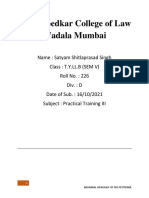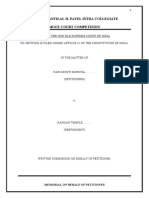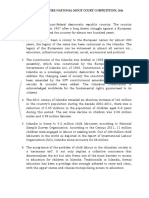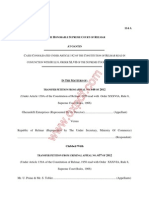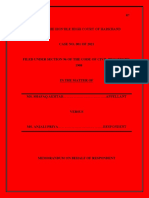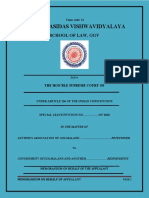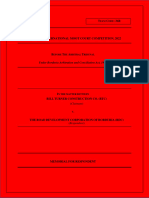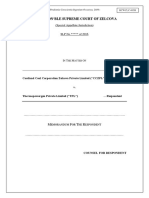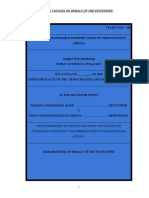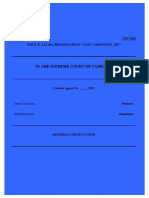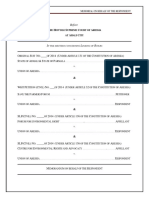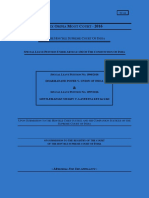Respondent's Memo
Respondent's Memo
Uploaded by
sagarCopyright:
Available Formats
Respondent's Memo
Respondent's Memo
Uploaded by
sagarOriginal Description:
Copyright
Available Formats
Share this document
Did you find this document useful?
Is this content inappropriate?
Copyright:
Available Formats
Respondent's Memo
Respondent's Memo
Uploaded by
sagarCopyright:
Available Formats
C-32
1st P.A. INAMDAR INTERNATIONAL MOOT COURT COMPETITION,
2016
IN THE HONBLE SUPREME COURT OF MALP
ORIGINAL WRIT JURISDICTION
UNDER ARTICLE 32 OF THE CONSTITUTION OF MALP
WRIT PETITION (CIVIL) NO. 47 OF 2016
YOUNG PALSHTIYA WOMEN ORGANISATION
(PETITIONER)
V.
UNION OF MALP & ORS.
(RESPONDENTS)
&
WRIT PETITION (CIVIL) NO. 23 OF 2016
MS. X
(PETITIONER)
V.
TRANS PALSHIAN UNIVERSITY& ORS.
(RESPONDENTS)
UPON SUBMISSION TO THE HONBLE CHIEF JUSTICE AND HIS COMPANION JUSTICES OF THE
SUPREME COURT OF MALP
ON SUBMISSION TO THE REGISTRY OF THE COURT
OF THE HONBLE SUPREME COURT OF MALP
~MEMORIAL FOR THE RESPONDENT ~
1st P.A. INAMDAR INTERNATIONAL MOOT COURT COMPETITION, 2016
MEMORIAL for THE RESPONDENT
LIST OF ABBREVIATIONS
LIST OF ABBREVIATIONS
ABBREVIATIONS
EXPANSIONS
PARAGRAPH
PARAGRAPHS
A.P
ANDHRA PRADESH
AIR
ALL INDIA REPORTER
APP.
APPLICATION
ART.
ARTICLE
ASS.
ASSAM
BIH.
BIHAR
DEL.
DELHI
ECHR
EUROPEAN COURT OF HUMAN RIGHTS
GUJ.
GUJARAT
HC
HIGH COURT
H.P
HIMACHAL PRADESH
HAR.
HARYANA
KARNA.
KARNATAKA
LJ.
LAW JOURNAL
LTD.
LIMITED
MAD.
MADRAS
MAH.
MAHARASHTRA
NGO
NON-GOVERNMENTAL ORGANISATION
NO.
NUMBER
PG.
PAGE
PME
PRE- MEDICAL EXAMINATION
SC
SUPREME COURT
1st P.A. INAMDAR INTERNATIONAL MOOT COURT COMPETITION, 2016
MEMORIAL for THE RESPONDENT
LIST OF ABBREVIATIONS
SCC
SUPREME COURT CASES
SCR
SUPREME COURT REPORT
SUPP.
SUPPLEMENTARY
T.N.
TAMIL NADU
U.K
UNITED KINGDOM
U.O.I
UNION OF INDIA
U.P
UTTAR PRADESH
U.S
UNITED STATES
WP
WRIT PETITION
YPWO
YOUNG- PALSHTIYA WOMEN ORGANISATION
1st P.A. INAMDAR INTERNATIONAL MOOT COURT COMPETITION, 2016
MEMORIAL for THE RESPONDENT
INDEX of AUTHORITIES
TABLE OF CONTENTS
INDEX OF AUTHORITIES ............................................................................................... 3
WRIT PETITION NO. - 47 ................................................................................................. 3
CASES...................................................................................................................................... 3
ARTICLES................................................................................................................................ 5
BOOKS
.................................................................................................................................... 5
UNITED NATIONS INSTRUMENT .............................................................................................. 5
INTERNATIONAL CONVENTIONS ............................................................................................ 5
WRIT PETITION NO. - 23 ................................................................................................. 6
CASES...................................................................................................................................... 6
BOOKS
.................................................................................................................................... 7
ARTICLES................................................................................................................................ 7
LEXICON ................................................................................................................................. 8
CONSTITUTIONAL PROVISIONS ................................................................................ 8
WEB RESOURCES ............................................................................................................. 8
STATEMENT OF JURISDICTION .................................................................................. 9
STATEMENT OF FACTS ................................................................................................ 10
STATEMENT OF ISSUES ............................................................................................... 12
SUMMARY OF ARGUMENTS ....................................................................................... 13
ARGUMENTS ADVANCED .............................................................................................. I
WRIT PETITION NO.- 47
I. THAT THE WRIT PETITION IS NOT MAINTAINABLE IN THE INSTANT
CASE: .................................................................................................................................... I
1. NO VIOLATION OF FUNDAMENTAL RIGHTS ....................................................................... I
2. EXISTENCE OF AN ALTERNATIVE REMEDY....................................................................... II
II. THAT FUNDAMENTAL RIGHTS UNDER ART. 14 HAVE NOT BEEN
VIOLATED IN THE INSTANT CASE ............................................................................ II
1. LOCUS OF ARBITRARINESS AND ITS INAPPLICABILITY IN THE INSTANT CASE............... III
2.THE AUTHORITIES HAVE APPLIED PRINCIPLE OF REASONABLENESS AND THE IMPUGNED
CIRCULAR IS WELL WITHIN THE CONTOURS OF THE PROCEDURE ESTABLISHED BY LAW III
III. THAT FUNDAMENTAL RIGHTS UNDER ARTICLE 25 HAVE NOT BEEN
VIOLATED IN THE INSTANT CASE: ......................................................................... III
1.WEARING OF RELIGIOUS ATTIRE IS NOT AN ESSENTIAL RELIGIOUS PRACTICE AND NOT
PROTECTED UNDER ARTICLE 25(1) .................................................................................... III
1|Page
1st P.A. INAMDAR INTERNATIONAL MOOT COURT COMPETITION, 2016
MEMORIAL for THE RESPONDENT
INDEX of AUTHORITIES
2. RIGHTS UNDER ART. 25 ISNT AN ABSOLUTE RIGHT .......................................................IV
3. THE RIGHT TO RELIGION IS SUBJECT TO FUNDAMENTAL RIGHTS OF OTHERS ...............VI
4. THE IMPUGNED CIRCULAR IS IN VIOLATION OF INTERNATIONAL CONVENTIONS ....... VII
WRIT PETITION NO.- 23
I. THAT THE WRIT PETITION IS NOT MAINTAINABLE IN THE CURRENT
CASE- ..................................................................................................................................IX
II. THE IMPUGNED ORDER WAS WELL WITHIN THE RIGHTS GUARANTEED
UNDER ART. 30 (1) ........................................................................................................... X
1. A
MINORITY EDUCATIONAL INSTITUTION HAS THE RIGHT TO ADMINISTER ITS OWN
INTERNAL ISSUES IN ACCORDANCE WITH ITS RELIGIOUS PRECEPTS ..................................XI
2. THAT ARTICLE 30 (1) GUARANTEES MINORITY INSTITUTIONS THE RIGHT TO ADMINISTER
THEIR OWN ISSUES WITH LIMITED STATE INTERFERENCE .................................................XI
III. THE RIGHTS UNDER ARTICLE 15 AND ARTICLE 14 OF THE
CONSTITUTION HAS NOT BEEN VIOLATED ....................................................... XII
TERM SEX AS USED IN ARTICLE 15 (1) CANNOT BE INTERPRETED SO AS TO
INCLUDE SEXUAL ORIENTATION ..................................................................................... XII
1. THE
2. THE EXPANSIVE INTERPRETATION OF ART. 15 (1) WILL INTERFERE WITH THE RIGHTS
GUARANTEED UNDER ARTICLE 29................................................................................... XIII
3. THAT THE RELIANCE ON FOREIGN JUDGEMENTS IS MISLEADING AND IMPROPER .... XIII
4. IMPACT OF INTERPRETING THE WORD SEX TO INCLUDE SEXUAL ORIENTATION ON
MALPIAN SOCIETY: ..........................................................................................................XIV
4.1 IMPACT ON THE INSTITUTION OF MARRIAGE .......................................................... XIV
4.2 IMPACT ON THE INSTITUTION OF FAMILY.............................................................. XIV
4.3 IMPACT ON OTHER CONSTITUTING ELEMENTS OF SOCIETY ....................................... XV
4.4 POTENTIAL NEGATIVE IMPACTS OF EXPANSIVE INTERPRETATION OF ART 15 ON PUBLIC
HEALTH .............................................................................................................................. XV
PRAYER ............................................................................................................................... I
2|Page
1st P.A. INAMDAR INTERNATIONAL MOOT COURT COMPETITION, 2016
MEMORIAL for THE RESPONDENT
INDEX of AUTHORITIES
I NDEX OF AUTHORITIES
WRIT PETITION NO. - 47
CASES
SR. NO.
SUPREME COURT CASES
PG. NO.
1.
Acharya Mahajshri Narendra Prasadji Anand Prasadji Maharaj
v. State of Gujarat, AIR 1975 SC 2098 : (1975) 1 SCC 11
Acharya Mahajshri Narendra Prasadji Anand Prasadji Maharaj
v. State of Gujarat, AIR 1975 SC 2098 : (1975) 1 SCC 11
Andhra Industrial Works v. Chief Controller of Imports and
Ors AIR 1974 SC 1539
Avinash Chand Gupta v. State of Uttar Pradesh, (2004) 2 SCC
726
BALCO Employees Union (Regd.) v. Union of India (2002) 2
SCC 333
Church of God (full Gospel) in India v. K.K.R Majestic Colony
Welfare Association, (2000) 7 SCC 282 : AIR 2000 SC 2773
Commissioner of Police v. Acharya Jagadishwarananda
Avadhuta, AIR 2004 SC 2984 : (2004) 12 SCC 770
Dalbir v. State of Punjab, AIR 1962 SC 1106 : 1962 Supp (3)
SCR 25
Dalbir v. State of Punjab, AIR 1962 SC 1106 : 1962 Supp (3)
SCR 25
Daryao v. The State of Uttar Pradesh, AIR 1961 SC 1457
IV
Ghosh v. Joseph, AIR 1963 SC 812 : 1963 Supp (1) SCR 789
Guruvayur Devaswom Managing Committee v. CK Rajan and
Ors. (2003) 7 SCC 546
Kesavananda Bharati v. State of Kerala, (1973) 4 SCC 225
Madhu Limaye v. D.M., AIR 1971 SC 2486 : (1970) 3 SCC 746
Maneka Gandhi v. Union of India, (1978) 1 SCC 248
V
I
2.
3.
4.
5.
6.
7.
8.
9.
10.
11.
12.
13.
14.
15.
16.
17.
18.
19.
IV
I
II
I
VI
IV
V
V
II
II
V
I
N. Adithayan v. Travancorre Dewaswom Board, (2002) 8 SCC
106 : AIR 2002 SC 3538
Namit Sharma v. Union of India, (2013) 1 SCC 745
IV
Narayan v. State of A.P., AIR 1996 SC 1765 : (1996) 3 SCR
543 : (1996) 9 SCC 548
Praveen Singh V. State Of Punjab., (2000) 8 S.C.C. 633
III
3|Page
III
1st P.A. INAMDAR INTERNATIONAL MOOT COURT COMPETITION, 2016
MEMORIAL for THE RESPONDENT
INDEX of AUTHORITIES
20.
Quareshi v. State of Bihar, AIR 1958 SC 731 : 1959 SCR 629
21.
Ramjilal v. Income Tax Officer, AIR 1951 SC 97
22.
II
23.
Secretary, Govt. of India v. Alka Subhash Gadia, 1990 SCR,
Supl. (3) 583
SIOI v. CBSE, WP Civil No. 486/2015
24.
Smt. Indira Nehru Gandhi v. Raj Narain, 1975 Supp. SCC 1
II
25.
Soma Chakravorthy v. C.B.I., (2007) 5 S.C.C. 403, at p. 411
II
26.
State of W.B v. Ashutosh, AIR 1995 SC 464 : (1995) 1 SCC 189
III
27.
28.
V
II
29.
Supdt. v. Ram Manohar, AIR 1960 SC 633 : (1960) 2 SCR 821
Tinkushia Electric Supply Co. V. State Of Ass. , A.I.R. 1990
S.C. 123
Union of India v. Paul Manickam, AIR 2003 SC 4622
SR. NO.
HIGH COURT CASE
PG. NO.
1.
Ali Akbar v. Dt. Musiff Pudukkotiar, AIR 1993 Mad 51
III
II
VI
SR. NO.
ECHR CASE
PG. NO.
1.
Dahlab v. Switzerland Application No 42393/98 (2001,
European Court of Human Rights)
Dogru v. France [2008] ECHR 1579
El Morsi v. France, Application no. 15585/06 (2008,
European Court of Human Rights)
European Convention for protection of Human Rights and
Fundamental Freedoms as amended by Protocol 11 of 2000
Kervanci v. France, Application no. 31645/04, (2008, European
Court of Human Rights)
Kose and 93 others v. Turkey, Application no. 26625/02, (2006,
European Court of Human Rights)
Kurtumulus v. Turkey, App no. 65500/01 (2006, European
Court of Human Rights)
Leyla Sahin v. Turkey Application no. 44774/98 (2004,
European Court of Human Rights)
Mannousakis v Greece, Application No.18784/91 (1996,
IV
2.
3.
4.
5.
6.
7.
8.
9.
IV
IV
IV
IV
IV
IV
IV
VIII
ECHR)
10.
Phull v. France, Dec No. 35753/03, (2005, European Court of
Human Right)
4|Page
IV
1st P.A. INAMDAR INTERNATIONAL MOOT COURT COMPETITION, 2016
MEMORIAL for THE RESPONDENT
INDEX of AUTHORITIES
ARTICLES
Utkarsh Anand, SC to PMT students: Faith wont disappear if
you
dont
dont
wear
headscarf(hijab)
one
day,http://indianexpress.com/article/india/india-others/aipmtsupreme-court-refuses-to-allow-hijab-in-test/
Ronjoy Sen, Legalizing Religion: The Indian Supreme Court
and Secularism, East West Centre Washington 9, 11 (2007)
PG. NO.
V
SR. NO.
BOOKS
PG. NO.
1.
VI
2.
Professor M.P Jain, Indian Constitutional Law, (Samaraditya
Pal, Justice Ruma Pal, 6th Ed., 2013)
Durga Das Basu's Commentary on the Constitution of India,
(Justice Y.V Chandrachud, Justice S.S Subbramani, Justice
B.P Banerjee, 8th Ed. 2008)
SR. NO.
UNITED NATIONS INSTRUMENT
PG. NO.
1.
UN Economic and Social Council, Siracusa Principles on the
Limitation and Derogation Provisions in the
International Covenant on Civil and Political Rights, UN Doc
E/CN.4/1985/4, Annex (1985)
VIII
SR. NO.
INTERNATIONAL CONVENTIONS
PG. NO.
SR. NO.
1.
2.
III
1.
American Convention on Human Rights, 1969
IV
2.
Arab Charter on Human Rights, 2003
IV
3.
European Convention for protection of Human Rights and
IV
Fundamental Freedoms as amended by Protocol 11 of 2000
4.
European Convention on Human Rights, 1953
VII
5.
International Covenant on Civil and Political Rights, 1966
IV
6.
7.
The African Charter on Human's and People's Rights, 1981
The Convention on the Elimination of all Forms of
Discrimination Against Woman, 1979
United Nations Declaration on the Elimination of All Forms of
Intolerance and of Discrimination Based on Religious Belief,
1981
Universal Declaration of Human Rights, 1948
IV
VII
8.
9.
5|Page
III
IV
1st P.A. INAMDAR INTERNATIONAL MOOT COURT COMPETITION, 2016
MEMORIAL for THE RESPONDENT
INDEX of AUTHORITIES
WRIT PETITION NO. - 23
SR. NO.
1.
2.
3.
4.
5.
6.
7.
8.
9.
10.
11.
12.
13.
14.
15.
16.
17.
18.
19.
20.
21.
22.
23.
24.
CASES
SUPREME COURT CASES
PG. NO.
All Saints High School v. Govt. of A.P., (1980) 2 SCC 478
Avinash Chand Gupta v. State of Uttar Pradesh, (2004) 2 SCC 726
Badrul Hasan Quadri v State of UP, AIR 1992 All 220
Council of Civil Service Unions v. Minister for the Civil Service 1985
AC 374, 414
Daryao v. The State of Uttar Pradesh, AIR 1961 SC 1457
G. Sundarrajan v. Union of India, (2013) 6 SCC 620, 646
Islamic Academy of Education v. State of Karnataka, AIR 2003 SC
3724
Kamgar Union v. Union of India, (1981) 1 SCC 568
Lilly Kurian v. Sr. Lewina, (1979) 2 SCC 124
M.P Oil Extaction v. Union of M.P (1997) 7 SCC 592
Malankara Syrian Catholic College v Jose, (2007) 1 SCC 386
P.A. Inamdar v. State of Maharashtra 2005 (6) SCC 537
Rev Sidhrajbhai v. State of Gujrat, AIR 1963 SC 540
Rev. Father W. Post v. State of Bihar, AIR 1969 SC 465
Secretary, Govt. of India v. Alka Subhash Gadia, 1990 SCR, Supl. (3)
583
St. Stephens college v. University of Delhi, (1992) 1 SCC 558
St. Xaviers College v. State of Gujarat & Anr. (1964) 1 SCC 717
State of Kerala v. Mother Provincial, (170) 2 SCC 417
State of Madras v. V.G Row, AIR 1952 SC 196
Suresh Kumar Koushal v. Naz Foundation, (2014) 1 SCC 1
T.M.A. Pai Foundations v. State of Karnataka, (2002) 8 SCC 481
Ugar Sugar Works Ltd v. Delhi Admin (2001) 3 SCC 635
Union of India v. Paul Manickam, AIR 2003 SC 4622
Yusuf v. State of Bombay, 1954 SCR 930: AIR 1954 SC 321
XII
II
XI
IX
II
IX
XII
III
XII
IX
XI
XI
XII
XII
II
XII
XI
XII
IX
X
XI
IX
II
XII
SR. NO.
HIGH COURT CASES
PG. NO.
1.
2.
K.P. Shukla v. State of Maharashtra, 1997 AIHC 3025 (Bom)
Naz Foundation v. Government Of N.C.T. Of Delhi, 160 Delhi
Law Times 277
XII
X
6|Page
1st P.A. INAMDAR INTERNATIONAL MOOT COURT COMPETITION, 2016
MEMORIAL for THE RESPONDENT
INDEX of AUTHORITIES
SR. NO.
US CASES
PG. NO.
1.
Frazee v. Illinois Department of Employment Security 489 US
829 (1989, Supreme Court of US)
2.
Hobbie v. Unemployment Appeals Commission 480 US 136
(1987, Supreme Court of US)
3.
Sherbert v. Verner, 374 US 398 (1963, Supreme Court of
South Carolina)
SR. NO.
P.C.I.J. CASE
PG. NO.
1.
Minority Schools in Albania, Advisory Opinion, 1935 P.C.I.J.
XIII
(ser. A/B) No. 64
SR. NO.
BOOKS
PG. NO.
1.
D.D BASU, Commentary on the Constitution of India, (J. Y V
Chandrachud, J. S S Subramani and J. B P Banerjee, 8th Ed.,
2007)
Durga Das Basu, Shorter Constitution Of India, (13th Ed.,
2001)
Handbook on the Law of Cultural Heritage and International
Trade, (James A.R. Nafziger and Robert Kirkwood Paterson,
2014)
Justice Hosbet Suresh, All Human Rights are Fundamental
Rights, (2nd Ed., 2013)
XII
2.
3.
4.
SR. NO.
1.
2.
3.
ARTICLES
Make Room for Daddy and Poppa, The Chicago Tribune,
March 24, 2002
Gay Parents and the Adoption Option, The Philadelphia
Inquirer, March 04, 2002
Technical Report: Coparent or Second-Parent Adoption by
Same-Sex Parents, Pediatrics, 109(2):(2002)
7|Page
II
XIII
IX
PG. NO.
XVI
XVI
XVI
1st P.A. INAMDAR INTERNATIONAL MOOT COURT COMPETITION, 2016
MEMORIAL for THE RESPONDENT
LEXICON
SR. NO.
1.
INDEX of AUTHORITIES
BLACKS LAW DICTIONARY (Bryan A. Garner, 7th ed.,
PG. NO.
XI
1999)
SR. NO.
CONSTITUTIONAL PROVISIONS
PG. NO.
1.
2.
3.
4.
5.
6.
7.
8.
9.
Article 12
Article 13
Article 14
Article 15
Article 21
Article 25
Article 29
Article 30
Article 32
passim
passim
passim
passim
passim
passim
passim
passim
passim
WEB RESOURCES
SR. NO.
1.
www.westlaw.india.com(WEST LAW INDIA)
2.
www.manupatrafast.com(MANUPATRA)
3.
www.judis.nic.in(SUPREME COURT OF INDIA OFFICIAL)
4.
www.jstor.org(JSTOR)
5.
www.scconline.com(SCC ONLINE)
6.
www.legal.un.org. (UNITED NATIONS)
8|Page
1st P.A. INAMDAR INTERNATIONAL MOOT COURT COMPETITION, 2016
MEMORIAL for THE RESPONDENT
STATEMENT of JURISDICTION
S TATEMENT OF J URISDICTION
The Petitioner has humbly approached the Honble Court under Article 32 of the Constitution of
Malp. The present memorandum contains the facts, contentions and arguments of the present case.
9|Page
1st P.A. INAMDAR INTERNATIONAL MOOT COURT COMPETITION, 2016
MEMORIAL for THE RESPONDENT
STATEMENT of FACTS
S TATEMENT OF FACTS
WRIT PETITION-47
1. HISTORICAL BACKGROUND OF PALSHTIYAS IN REPUBLIC OF MALP: Malp remained
under the rule of Palsh, a developed Western nation. During the Palshian era in Malp,
several Palshian philosophers & religious leaders brought about considerable impact upon
the Palshian culture in the territory. Therefore, a major sec. of the Malpian society adopted
Palshtiya religion.
2. THE PREVAILING LEGAL SYSTEM IN MALP: The text of the Constitution of Malp is same
as that of the Constitution of India. As such all the statutes, laws, etc. in force in India are
also mutatis mutandis applicable in Malp. It is also a member of the UNO and is a party to
the international conventions, treaties etc in the same manner as India.
3. CIRCUMSTANCES
LEADING TO ISSUE OF IMPUGNED CIRCULAR BY THE
MEB: MEB of
Malp is the central body responsible for regulation of medical education in the country. In
the year 2015, PMEs were held across the country and large scale cheating syndicate was
unearthed. On a WP filed by several aspirants, the Apex Court of the country set aside the
entire examination and ordered for fresh examination. As a result, the MEB issued the
impugned circular wherein the candidates were prohibited from wearing headgear like
headscarves, burqa, habit etc., so as to prevent employing of hidden gadgets.
4. CIRCUMSTANCES
LEADING TO FILING OF INSTANT WRIT PETITION BEFORE
HONBLE
COURT: YPWO, a registered NGO filed the instant PIL under Art. 32 of the Constitution
and challenged the constitutional validity of the impugned circular. The orders violated the
cultural rights of Palshtiya women of wearing the headscarf and full sleeve dress, as it is
mandated by their religion to be the dress code in public and also affected Shran women,
who do not have such dress code.
10 | P a g e
1st P.A. INAMDAR INTERNATIONAL MOOT COURT COMPETITION, 2016
MEMORIAL for THE RESPONDENT
STATEMENT of FACTS
WRIT PETITION-23
1. SITUATION
IN
MALP: The Republic of Malp is a developing country which is well
diversified in terms of religion, language and culture. In modern times, Malp has seen a
change in the outlook of the society and social-inclusion of the weaker and stigmatised
sections of the society like the LGBT community which had been for long considered
as an unprivileged class and a marginalised section is now visible as an active part of
the society, enjoying an improved status therein.
2. PREVAILING LEGAL SYSTEM: The text of the Constitution of Malp is same as that of the
Constitution of India. As such all the statutes, laws etc. in force in India are also mutatis
mutandis applicable in Malp. It is also a member of the UNO and is a party to the
international conventions, treaties etc. and has ratified them, in a manner similar to those
by India.
3. CIRCUMSTANCES LEADING TO FILING OF WP BEFORE THE HONBLE COURT: Ms. X, a
Palayan native of the Shran faith, took admission in the Trans Palshtiya University, a
state aided religious institution, where she was allotted a room in a hostel. However,
soon afterwards, the university received complaints from other girls that they did not
wish to stay with her on account of her sexual orientation as a lesbian. Considering this,
the university had to cancel her room allotment. Ms. X filed a WP under Art. 32 before
the SC challenging the constitutional validity of the aforesaid order, contending that the
order was arbitrary and hence violative of Art. 14 of the Constitution of Malp.
Furthermore, she seeks to assert that the fundamental right against discrimination on the
basis of sex inscribed in Art. 15(1) in the Constitution includes within its ambit the right
against discrimination on the basis of sexual orientation. On this ground she has
assailed the validity of the universitys order as also being violative of Art. 15(1).
11 | P a g e
1st P.A. INAMDAR INTERNATIONAL MOOT COURT COMPETITION, 2016
MEMORIAL for THE RESPONDENT
STATEMENT of ISSUES
S TATEMENT OF I SSUES
WRIT PETITION-47
[ISSUE I]
WHETHER THE WRIT PETITION IS MAINTAINABLE IN THE INSTANT CASE?
[ISSUE II]
WHETHER THE FUNDAMENTAL RIGHTS UNDER ARTICLE 14 OF THE CONSTITUTION OF MALP
HAVE BEEN VIOLATED IN THE INSTANT CASE?
[ISSUE III]
WHETHER THE FUNDAMENTAL RIGHTS UNDER ARTICLE 25 OF THE CONSTITUTION OF MALP
HAVE BEEN VIOLATED IN THE INSTANT CASE?
WRIT PETITION- 23
[ISSUE I]
WHETHER THE WRIT PETITION IS MAINTAINABLE IN THE INSTANT CASE?
[ISSUE II]
WHETHER THE FUNDAMENTAL RIGHTS UNDER ARTICLE 14 AND ARTICLE 15 OF THE
CONSTITUTION OF MALP HAVE BEEN VIOLATED IN THE INSTANT CASE?
[ISSUE III]
WHETHER THE IMPUGNED ORDER WAS WITHIN THE RIGHTS GUARANTEED UNDER ARTICLE 30?
12 | P a g e
1st P.A. INAMDAR INTERNATIONAL MOOT COURT COMPETITION, 2016
MEMORIAL for THE RESPONDENT
SUMMARY of ARGUMENTS
S UMMARY OF A RGUMENTS
WRIT PETITION - 47
[ISSUE I] WHETHER THE WRIT PETITION IS NOT MAINTAINABLE IN THE
INSTANT CASE?
The writ Petition is not maintainable in the instant case. The fundamental rights of the petitioner
have not been violated. Even so, the fundamental rights are subject to inherent limitations
which are imposed by the Constitution itself and an existence of alternative remedy is sufficient
to make the petition fail.
[ISSUE II] WHETHER THE FUNDAMENTAL RIGHTS UNDER ARTICLE 14 OF
THE CONSTITUTION HAVE NOT BEEN VIOLATED?
The right under Article 14 of the Constitution is not violated. Article 14 includes the principle
of reasonableness and it requires government to act on reasonable grounds. Court while
adjudging administrative actions can see the legality and not the merits of the decision.
Considering the situation at hand, the circular issued by MEB is not an illegal or arbitrary
decision and it is made in pursuance of ensuring fairness and transparency and instilling public
faith in the examination system. Hence Article 14 is not violated in the present case.
[ISSUE III] WHETHER THE FUNDAMENTAL RIGHTS UNDER ARTICLE 25 OF
THE CONSTITUTION HAVE NOT BEEN VIOLATED?
It is humbly submitted that the circular issued by the Medical Education Board of Malp has
been issued in pursuance of the judgement passed by the Honble Supreme Court of Malp and
does not contravene the rights guaranteed under Article 25 of the Constitution of Malp.
13 | P a g e
1st P.A. INAMDAR INTERNATIONAL MOOT COURT COMPETITION, 2016
MEMORIAL for THE RESPONDENT
SUMMARY of ARGUMENTS
WRIT PETITION-23
[ISSUE I] WHETHER THE WRIT PETITION IS NOT MAINTAINABLE IN THE
INSTANT CASE?
The writ Petition is not maintainable in the present case. The fundamental rights of the
petitioner have not been violated in the instant case. The interpretation of the word sex as
contended by the petitioner to include sexual orientation is extraneous and far-fetched and in
no way is justified by the Constitution.
[ISSUE II] WHETHER THE IMPUGNED ORDER WAS WELL WITHIN THE
RIGHTS GUARANTEED UNDER ARTICLE 30?
That the cancellation of the room allotment was an administrative decision based on the
complaints of the boarders. As a minority educational institution, it has the right to administer
its own internal issues in accordance with its religious precepts. Art. 30 allows minority
institutions to administer its own issues with only limited state interference.
[ISSUE III] WHETHER FUNDAMENTAL RIGHTS UNDER ARTICLE 15 AND
ARTICLE 14 OF THE CONSTITUTION HAVE NOT BEEN VIOLATED?
That there has been no violation of rights under Art. 15. Further, there has been no violation of
Art. 14 as the impugned order was not arbitrary in nature and and has not violated any of the
rights guaranteed therein. The expansive interpretation of the article, which has relied
extensively on foreign case laws and statutes is flawed and improper as they only serve to
import the foreign culture and customs of those countries. This in turn will lead to the
breakdown of social and cultural norms of Malpian society.
14 | P a g e
1st P.A. INAMDAR INTERNATIONAL MOOT COURT COMPETITION, 2016
MEMORIAL for THE RESPONDENT
ARGUMENTS ADVANCED
ARGUMENTS A DVANCED
WRIT PETITION - 47
I.
THAT THE WRIT PETITION IS NOT MAINTAINABLE IN THE INSTANT CASE.
It is humbly submitted that a PIL can be filed under Article 321 for enforcement of Fundamental
Rights, as guaranteed by part III of the Constitution2. In the instant case, firstly, there has been
no violation of any fundamental rights and secondly, the petitioner has failed to exhaust his
alternative remedy.
1. NO VIOLATION OF FUNDAMENTAL RIGHTS: The jurisdiction under Art. 32 can be invoked
only when Fundamental Rights are violated3. It has been held that if a right, other than a
fundamental right is claimed to be violated then such questions can be addressed only in the
appropriate proceedings and not on an application under Art. 324. In the instant case, that there
has been no direct and inevitable effect on the fundamental rights.5 Further any violation of
fundamental right as claimed by the petitioner is non-existing and illusionary.6 It is submitted
Article 32, Constitution of Malp.
Andhra Industrial Works v. Chief Controller of Imports and Ors AIR 1974 SC 1539 10; Guruvayur Devaswom
Managing Committee v. CK Rajan and Ors. (2003) 7 SCC 546 50; BALCO Employees Union (Regd.) v. Union
of India, (2002) 2 SCC 333.
3
Durga Das Basu's Commentary on the Constitution of India, 3705 (Justice Y.V Chandrachud, Justice S.S
Subbramani, Justice B.P Banerjee, 8th Ed. 2008).
4
Ramjilal v. Income Tax Officer, AIR 1951 SC 97.
Maneka Gandhi v. Union of India, (1978) 1 SCC 248; Namit Sharma v. Union of India, (2013) 1 SCC 745.
9,7, MOOT PROPOSITION, P.A INAMDAR INTERNATIONAL MOOT COURT COMPETITION, 2016.
I|Page
1st P.A. INAMDAR INTERNATIONAL MOOT COURT COMPETITION, 2016
MEMORIAL for THE RESPONDENT
ARGUMENTS ADVANCED
that in the second part of the submission it will be shown that there is no violation of
fundamental right under Article 14 and Article 25 of the Malpian constitution.
2.EXISTENCE
OF AN ALTERNATIVE REMEDY:
It has been held that Art. 32 confers extra-
ordinary jurisdiction, the same must be used sparingly and in circumstances where no
alternative remedy is available.7 Art. 32(1) confers a right to move the SC by appropriate
proceedings. Appropriate proceedings include procedural factors such as res judicata 8, delay
in filing the petition and parallel proceedings9 in another court. The petitioner in the instant
case had the remedy to approach the Honble HC.10
It is submitted that the petitioner had an alternative remedy to approach the High court under
Art. 226. The power of High Court under Art. 226 is wider than the powers of this Court under
Art. 32 of the Constitution. Considering the points raised, it is submitted that the petition must
fail.
II.
THAT FUNDAMENTAL RIGHTS UNDER ART. 14 HAVE NOT BEEN VIOLATED
IN THE INSTANT CASE.
It is humbly submitted Art. 14 of the Malpain Constitution envisage equal protection or equal
treatment in similar circumstances11. Art. 14 is a basic structure.12 The requirement of the
Secretary, Govt. of India v. Alka Subhash Gadia, 1990 SCR, Supl. (3) 583; Avinash Chand Gupta v. State of
Uttar Pradesh, (2004) 2 SCC 726; Union of India v. Paul Manickam, AIR 2003 SC 4622.
8
Daryao v. The State of Uttar Pradesh, AIR 1961 SC 1457.
Durga Das Basu, Shorter Constitution of India, 396 (13th ed., 2001).
10
Article 226, Constitution of Malp.
11
Tinkushia Electric Supply Co. v. State Of Ass. , AIR 1990 SC 123.
12
Kesavananda Bharati v. State of Kerala, (1973) 4 SCC 225; Smt. Indira Nehru Gandhi v. Raj Narain, 1975
Supp. SCC 1.
II | P a g e
1st P.A. INAMDAR INTERNATIONAL MOOT COURT COMPETITION, 2016
MEMORIAL for THE RESPONDENT
ARGUMENTS ADVANCED
validity of a law with reference to Art. 14 is that it should not be arbitrary and classification
should be reasonable13.
1.LOCUS OF ARBITRARINESS AND ITS INAPPLICABILITY IN THE INSTANT CASE: There is no cut
through strait jacket formula to evolve objectively, what amounts to arbitrariness but can only
be culled out from circumstances and facts14. In the instance case, the circular, as a
precautionary step, is issued in order to curb any likelihood of a cheating and fraud racket.
Considering the fact that the futures of the students are at stake, the impugned circular passes
the test of arbitrariness and is well within the prescribed realm of Art. 14.
2.THE
AUTHORITIES HAVE APPLIED PRINCIPLE OF REASONABLENESS AND THE IMPUGNED
CIRCULAR IS WELL WITHIN THE CONTOURS OF THE PROCEDURE ESTABLISHED BY LAW: It
is
submitted that Article 14 as including the principles of reasonableness only requires the
government to act on reasonable grounds.15 The court function is to check whether the decision
taken is fair and free from the taint of unreasonableness and has substantially complied with
the norm of procedure.16 The impugned circular is no way takes away FRs or vitiates any
procedure established by law.
III.
THAT FUNDAMENTAL RIGHTS UNDER ARTICLE 25 HAVE NOT BEEN
VIOLATED IN THE INSTANT CASE.
1.WEARING
OF RELIGIOUS ATTIRE IS NOT AN ESSENTIAL RELIGIOUS PRACTICE AND NOT
PROTECTED UNDER ARTICLE
25(1): The Essential Religious Practice doctrine is a derivative
13
Soma Chakravorthy v. C.B.I., (2007) 5 SCC 403, 411.
14
Praveen Singh v. State Of Punjab, (2000) 8 SCC 633.
15
Durga Das Basu's Commentary on the Constitution of India, 1360 (Justice Y.V Chandrachud, Justice S.S
Subbramani, Justice B.P Banerjee, 8th Ed. 2008).
16
Fertilizer Corpn Kamgar Union v. Union of India, (1981) 1 SCC 568, 584.
III | P a g e
1st P.A. INAMDAR INTERNATIONAL MOOT COURT COMPETITION, 2016
MEMORIAL for THE RESPONDENT
ARGUMENTS ADVANCED
discourse of the colonial era doctrine of "justice, equity and good conscience"17. It has been
held by the Supreme Court that in order to get protection of Article 25(1), the 'practice' in
question must be essential,18 or mandatory as distinguished from optional religious practice19.
It is such permanent essential parts of the religion which are protected by the Constitution.20 It
was further held that essential part means core beliefs upon which religion is founded. Essential
practice means those practices that are fundamental to follow a religious belief, without which
religion is no religion.21 The Madras High Court
22
has upheld that wearing of burqa by a
Muslim women was a mere religious custom and not an integral part of Islam. Therefore, the
same was not protected under Article 25(1) of the Constitution.
2.RIGHTS UNDER ART. 25 ARENT AN ABSOLUTE RIGHT: The Supreme Court has observed that
"no rights in an organised society can be absolute. Enjoyment of one's right must be consistent
with enjoyment of rights also by others."23 and more so, the right to religion has been expressly
subjected to public order, morality and health as enshrined under Article 25 (1) 24 and various
international instruments 25 have concurred the same.
17
Ronjoy Sen, Legalizing Religion: The Indian Supreme Court and Secularism, East West Centre Washington 9,
11 (2007) , available at http://www.eastwestcenter.org/fileadmin/stored/pdfs/PS030.pdf, last seen 08/03/2016.
18
Quareshi v. State of Bihar, AIR 1958 SC 731 : 1959 SCR 629 (739-40) CB; Narayan v. State of A.P., AIR 1996
SC 1765 : (1996) 3 SCR 543 : (1996) 9 SCC 548 ( 36, 43, 80, 83, 89).
19
State of W.B v. Ashutosh, AIR 1995 SC 464 : (1995) 1 SCC 189 ( 6, 11).
20
N. Adithayan v. Travancorre Dewaswom Board, (2002) 8 SCC 106 : AIR 2002 SC 3538.
21
Commissioner of Police v. Acharya Jagadishwarananda Avadhuta, AIR 2004 SC 2984 : (2004) 12 SCC 770.
22
M. Ajmal Khan v. Election Commission of India, Writ petition No. 26841/2006 (Madras High Court,
07/09/2006).
23
Acharya Mahajshri Narendra Prasadji Anand Prasadji Maharaj v. State of Gujarat, AIR 1975 SC 2098: (1975)
1 SCC 11.
24
Article 25(1), Constitution of Malp.
25
Article 18(2), International Covenant on Civil and Political Rights, 1966; Article 18, Universal Declaration of
Human Rights, 1948; Article 9(2), European Convention for protection of Human Rights and Fundamental
IV | P a g e
1st P.A. INAMDAR INTERNATIONAL MOOT COURT COMPETITION, 2016
MEMORIAL for THE RESPONDENT
ARGUMENTS ADVANCED
Several judicial decisions delivered by European Court of Human Rights 26, can also be
instrumental in order to appreciate that right to religious attire is subject to the power of the
State to frame laws. In the instant case, if at all breach of religious rights of Palshtyian women
subsists within the framework of Article 25, still it would be hit by 'public order'. Public order
is to be read synonymous to public safety and tranquillity 27 and also includes committing of
breach of discipline
28
and implies an orderly state affairs in which citizens can peacefully
pursue their normal avocations of life. 29
Moreover, the issuance of circular by MEB, was in pursuance of instilling public confidence
in the examination process, and ensuring transparency, authenticity and fairness of examination
system.30 In a secular State which guarantees constitutional protection to religious freedom,
secular matters should not be allowed to get mixed up with matters of religion. Where the
matter is clearly secular, there should be no difficulty for the State to legislate laws. In the case
of SIOI V. CBSE31, the Honble SC of India upheld the circular issued by CBSE that prohibited
burqa, hijab, full sleeve dresses etc to the examination hall, in order to curb cheating. The CJI
Freedoms as amended by Protocol 11 of 2000 , Article 12(3), American Convention on Human Rights, 1969
Article 30 (2), Arab Charter on Human Rights, 2003 ;Article 8, The African Charter on Human's and People's
Rights, 1981, Declaration on the Elimination of All Forms of Intolerence and of Discrimination based on Religion
or belief.
26
Phull v. France, Dec no. 35753/03, (2005, European Court of Human Right); El Morsi v. France, Application
no. 15585/06 (2008, European Court of Human Rights); Dahlab v. Switzerland Application no. 42393/98 (2001,
European Court of Human Rights); Kurtumulus v. Turkey, Application no. 65500/01 (2006, European Court of
Human Rights); Leyla Sahin v. Turkey Application no. 44774/98 (2004, European Court of Human Rights); Kose
and 93 others v. Turkey, Application no. 26625/02, (2006, European Court of Human Rights), Dogru v. France
[2008] ECHR 1579, Kervanci v. France, Application no. 31645/04, (2008, European Court of Human Rights).
27
Madhu Limaye v. D.M., AIR 1971 SC 2486: (1970) 3 SCC 746; Ghosh v. Joseph, AIR 1963 SC 812: 1963
Supp (1) SCR 789.
28
Dalbir v. State of Punjab, AIR 1962 SC 1106: 1962 Supp (3) SCR 25.
29
Supdt. v. Ram Manohar, AIR 1960 SC 633: (1960) 2 SCR 821.
30
9, 7, MOOT PROPOSITION, P.A INAMDAR INTERNATIONAL MOOT COURT COMPETITION, 2016.
31
Civil Petition No. 486/2015 (Supreme Court of India, 24/07/2015).
V|Page
1st P.A. INAMDAR INTERNATIONAL MOOT COURT COMPETITION, 2016
MEMORIAL for THE RESPONDENT
ARGUMENTS ADVANCED
while quashing the PIL brought forth by SIOI remarked that the "plea was nothing but an ego"
and he further observed that "the faith would not disappear if the students did not attend the
exams without scarf"32.
3.THE RIGHT TO RELIGION IS SUBJECT TO FUNDAMENTAL RIGHTS OF OTHERS: A person can
exercise his religious freedom so long as it does not come into conflict with the exercise of
Fundamental Rights of others.33 Enjoyment of one's right must be consistent with the
enjoyment of rights also by others. Where in a free play of social forces it is not possible to
bring about a voluntary harmony, the state has to step in to set right the imbalance between
competing interests.34The Court has further observed that "a particular Fundamental Right
cannot exist in isolation in a water tight compartment. One Fundamental Right of a person may
have to co-exist in harmony with the exercise of another Fundamental rights by others and
valid exercise of power by the State. 35
In Clause (3) of Article 18 of the International Covenant, it is provided that the freedom of
religion guaranteed by that Article 18 to everyone is subject to fundamental rights of others.36
Though there is no express provision in the Indian Constitution, in identical language, the same
conclusion can be drawn from the words 'subject to the other provisions of this part' 37 It also
32
Utkarsh Anand, SC to PMT students: Faith won't disappear if you don't wear scarf (hijab) one day, The Indian
Express (25/08/2015), available at http://indianexpress.com/article/india/india-others/aipmt-supreme-courtrefuses-to-allow-hijab-in-test/, last seen on 12/03/2016;
33
See Professor M.P Jain, Indian Constitutional Law, 349 (Samaraditya Pal, Justice Ruma Pal, 6th Ed., 2013).
34
Acharya Mahajshri Narendra Prasadji Anand Prasadji Maharaj v. State of Gujarat, AIR 1975 SC 2098: (1975)
1 SCC 11. See also Church of God (full Gospel) in India v. K.K.R Majestic Colony Welfare Association, (2000)
7 SCC 282: AIR 2000 SC 2773.
35
Part IV, Constitution of Malp.
36
Ali Akbar v. Dt. Musiff Pudukkotiar, AIR 1993 Mad 51.
37
Durga Das Basu's Commentary on the Constitution of India, 3481 (Justice Y.V Chandrachud, Justice S.S
Subbramani, Justice B.P Banerjee, 8th Ed. 2008).
VI | P a g e
1st P.A. INAMDAR INTERNATIONAL MOOT COURT COMPETITION, 2016
MEMORIAL for THE RESPONDENT
ARGUMENTS ADVANCED
follows from the general limitation to all human rights, as stipulated by Article 29(2) of the
Universal Declaration and Article 12(3) of the Covenant.
Therefore, the enforcement of rights guaranteed under Article 25 of Palshian female candidates
has to harmoniously co exist with rights of other candidates guaranteed under Article 14, who
are entitled a fair and authentic examination after the setting aside of the previous examination.
4.THE
IMPUGNED CIRCULAR IS IN VIOLATION OF INTERNATIONAL CONVENTIONS:
international conventions
38
Several
concur upon the fact that freedom of profession and practice of
religion are not absolute by nature. It can be concluded that limitation to the freedom of religion
is a limitation on the part of the right (right to manifest one's religion) which requires that such
limitation be prescribed by law and must be necessary to protect the 'public safety, order, health
or morals or the fundamental rights and freedom of others.
39
Though there is no express
provision in the Indian Constitution in identical language, the same conclusion must be drawn
under our Constitution from the words 'subject to other provisions of this Part' 40
The freedom to manifest one religion can only be limited if it is 'prescribed by law and
necessary in a democratic society in the interest of public safety, public order, health or morals,
or for the protection of rights and freedoms of others. 41 The Convention on the Elimination of
38
Article 18(2), International Covenant on Civil and Political Rights, 1966; Article 18, Universal Declaration of
Human Rights, 1948; Article 9(2), European Convention for protection of Human Rights and Fundamental
Freedoms as amended by Protocol 11 of 2000; Article 12(3), American Convention on Human Rights, 1969;
Article 30 (2), Arab Charter on Human Rights, 2003; Article 8, The African Charter on Human's and People's
Rights, 1981, Declaration on the Elimination of All Forms of Intolerence and of Discrimination based on Religion
or belief.
39
Article 18(3), International Covenant on the Civil and Political Rights, 1966; Article 12(3), African Convention
of Human Rights, 1969.
40
Durga Das Basu Commentary on the Constitution of India, 3453, (J. Y.V Chandrachud, Justice S.S Subramani,
Justice B.P Banerjee, 8th ed, 2008).
41
Article 9(2), European Convention on Human Rights, 1953.
VII | P a g e
1st P.A. INAMDAR INTERNATIONAL MOOT COURT COMPETITION, 2016
MEMORIAL for THE RESPONDENT
ARGUMENTS ADVANCED
all Forms of Discrimination Against Woman (CEDAW), 1979 defines the term 'discrimination
against woman' 42 and places obligation upon the state to condemn any such discrimination. 43
Several judicial cases 44 have affirmed that the right to wear religious attire cannot be held as
absolute. In Leyla Sahin v. Turkey
45
, Turkish Supreme Administrative Courts and European
Courts of Human Rights, upheld a circular that refused the admission of those "whose heads
were covered" in other words who wore Islamic headscarves as it was meant to uphold the
principles of secularism and the neutrality nature of universities 46. In another case, the Human
Rights Commission upheld the argument of Canadian Government wherein the government
restricted the right of a Sikh man to manifest his religion as they were justified under Public
Order and safety. 47
Furthermore, it can be stated that any restriction imposed on a right must be consistent with
other rights and must be in conformity with the State's other obligations under International
law.
48
In Mannousakis v Greece
49
, the Court held that the right of manifestation of belief
42
Article 1, Convention on the Elimination of All forms of Discrimination Against Women, 1979.
43
Article 2, Convention on the Elimination of All forms of Discrimination Against Women, 1979.
44
Phull v. France, Dec No. 35753/03, (2005, European Court of Human Right); El Morsi v. France, Application
no. 15585/06 (2008, European Court of Human Rights); Dahlab v. Switzerland Application no. 42393/98 (2001,
European Court of Human Rights); Kurtumulus v. Turkey, App no. 65500/01 (2006, European Court of Human
Rights); Leyla Sahin v. Turkey Application no. 44774/98 (2004, European Court of Human Rights); Kose and
93 others v. Turkey, Application no. 26625/02, (2006, European Court of Human Rights), Dogru v. France [2008]
ECHR 1579, Kervanci v. France, Application no. 31645/04, (2008, European Court of Human Rights).
45
Application no 44774/98 (2004, European Court of Human Rights).
46
Ibid, 82-84.
47
Communication 208/1986, Views Human Rights Committee, adopted on 9/11/1989.
48
UN Economic and Social Council, Siracusa Principles on the Limitation and Derogation Provisions in the
International Covenant on Civil and Political Rights, UN Doc E/CN.4/1985/4, Annex (1985).
49
Application No.18784/91 (1996, European Court of Human Rights).
VIII | P a g e
1st P.A. INAMDAR INTERNATIONAL MOOT COURT COMPETITION, 2016
MEMORIAL for THE RESPONDENT
ARGUMENTS ADVANCED
excludes the discretion of states to determine whether religious beliefs or the means used to
express them are legitimate.
WRIT PETITION-23
I.
THE SUIT IS NOT MAINTAINABLE IN THE CURRENT CASE.
It is submitted that the court should deny exercising its jurisdiction in the present case. The
Honble Courts in plethora of cases has held that restrictions imposed by the authorities50 must
not be held unreasonable merely because it seems unreasonable to the court, the court must
accept the judgement and intention51 of the authorities until there is a direct and inevitable
violation of fundamental right52.
It is submitted that Art. 32 is an absolute right and is subject to the self-imposed restraints
evolved by the judiciary.53 It has been held that Art. 32 confers extra-ordinary jurisdiction,
the same must be used sparingly and in circumstances where no alternative remedy is
available.54 Art. 32(1) confers a right to move the SC by appropriate proceedings. Appropriate
proceedings include procedural factors such as res judicata55, delay in filing the petition and
parallel proceedings in another court. The petitioner in the instant case had the remedy to
approach the Honble HC.56
50
51
Article 12, Constitution of Malp.
State of Madras v. V.G. Row, AIR 1952 SC 196, 200.
52
M.P Oil Extaction v. Union of M.P. (1997) 7 SCC 592; Ugar Sugar Works Ltd v. Delhi Admin (2001) 3 SCC
635; G. Sundarrajan v. Union of India, (2013) 6 SCC 620, 646; Council of Civil Service Unions v. Minister for
the Civil Service, 1985 AC 374, 414.
53
Justice Hosbet Suresh, All Human Rights are Fundamental Rights, 242, (2nd Ed. 2013).
54
Secretary, Govt. of India v. Alka Subhash Gadia, 1990 SCR, Supl. (3) 583; Avinash Chand Gupta v. State of
Uttar Pradesh, (2004) 2 SCC 726; Union of India v. Paul Manickam, AIR 2003 SC 4622.
55
Daryao v. The State of Uttar Pradesh, AIR 1961 SC 1457.
56
Article 226, Constitution of Malp.
IX | P a g e
1st P.A. INAMDAR INTERNATIONAL MOOT COURT COMPETITION, 2016
MEMORIAL for THE RESPONDENT
ARGUMENTS ADVANCED
Further, it is also submitted that the only case law that interpreted sex as inclusive of sexual
orientation in Art. 15 (1)57 was over-ruled by the Honble SC58. Further any violation of
fundamental right as claimed by the petitioner is non-existing and illusionary.59
It is submitted that in the second part of the submission it will be shown that there is no violation
of fundamental right under Article 14 and15 of the Indian constitution.
II.
THE IMPUGNED ORDER WAS WELL WITHIN THE RIGHTS GUARANTEED
UNDER ART. 30 (1).
1.THAT THE CANCELLATION OF THE ROOM ALLOTMENT WAS AN ADMINISTRATIVE DECISION
BASED ON COMPLAINTS RECEIVED FROM THE OTHER BOARDERS
The cancellation of Mrs
Xs room was because of other female boarders who clearly stated that they did not want to
reside with her in the same hostel.60 If the university officials had done nothing after receiving
the complaint, they would effectively have been unfairly forcing the rest of the boarders to stay
with Mrs X in the same building.61
At this point it should be clarified, that the reason that the other boarders complained about not
wanting to stay with Mrs X was due to her sexual orientation a lesbian and in the Palstiyan
faith, homosexuality is considered sinful behaviour which has also been confirmed by Mr.
Arnam, an expert on the religion and its philosophy.62
57
Suresh Kumar Koushal v. Naz Foundation, (2014) 1 SCC 1.
58
Naz Foundation v. Government of N.C.T. Of Delhi, 160 Delhi Law Times 277.
59
22, 10, MOOT PROPOSITION, P.A. INAMDAR INTERNATIONAL MOOT COURT COMPETITION 2016.
60
19, 10, MOOT PROPOSITION, P.A. INAMDAR INTERNATIONAL MOOT COURT COMPETITION 2016.
61
Sherbert v. Verner, 374 US 398 (1963, Supreme Court of South Carolina); Hobbie v. Unemployment Appeals
Commission, 480 US 136 (1987, Supreme Court of US); Frazee v. Illinois Department of Employment Security,
489 US 829 (1989, Supreme Court of US).
62
22, 10, MOOT PROPOSITION, P.A. INAMDAR INTERNATIONAL MOOT COURT COMPETITION 2016.
X|Page
1st P.A. INAMDAR INTERNATIONAL MOOT COURT COMPETITION, 2016
MEMORIAL for THE RESPONDENT
2.A
ARGUMENTS ADVANCED
MINORITY EDUCATIONAL INSTITUTION HAS THE RIGHT TO ADMINISTER ITS OWN
INTERNAL ISSUES IN ACCORDANCE WITH ITS RELIGIOUS PRECEPTS The term administer may
be defined as the management or performance of the executive duties of an institution. 63 The
Honble SC in the St. Xaviers college case64 said that the rights conferred under Art. 29(1)
included the right to conserve ones own culture. Article 30 (1) of the Constitution of India
gives linguistic and religious minorities a fundamental right to establish and administer
educational institutions of their choice.65 This will include the right to enable such a minority
to administer the institution in such a manner so as to enable them to preserve their own religion
or language66.
Considering the aforementioned circumstances, it can easily be concluded that the university
was well within the rights guaranteed under Article 30 (1) to cancel her room allotment.
3.THAT ARTICLE 30 (1) GUARANTEES MINORITY INSTITUTIONS THE RIGHT TO ADMINISTER
THEIR OWN ISSUES WITH LIMITED STATE INTERFERENCE This proposition of law enunciated
in T.M.A. Pai Foundation case67 is reiterated by Honble SC in P.A. Inamdar case68.
The right of minorities to establish and administer educational institutions69 of their choice
guaranteed under Article 30(1) is subject to the regulatory power of the State 70. Only
63
BLACKS LAW DICTIONARY, 44 (Bryan A. Garner 7th ed. 1999).
64
The Ahmedabad St. Xaviers College v. State of Gujarat & Anr., (1964) 1 SCC 717.
65
Malankara Syrian Catholic College v. Jose, (2007) 1 SCC 386; Badrul Hasan Quadri v. State of UP, AIR
1992 All 220.
66
P.A. Inamdar v. State of Maharashtra, 2005 (6) SCC 537.
67
T.M.A. Pai Foundations v. State of Karnataka, (2002) 8 SCC 481.
68
Supra 66.
69
Rev. Father W. Post v. State of Bihar, AIR 1969 SC 465; St. Stephens college v. University of Delhi, (1992)
1 SCC 558.
70
Supra 67.
XI | P a g e
1st P.A. INAMDAR INTERNATIONAL MOOT COURT COMPETITION, 2016
MEMORIAL for THE RESPONDENT
ARGUMENTS ADVANCED
regulations that embraced and reconciled the state interest with minorities interest could be
considered reasonable.71 The fundamental right guaranteed under Article 30(1) is intended to
be effective and should not be whittled down by any administrative exigency. 72
III.
THE RIGHTS UNDER ARTICLE 15 AND ARTICLE 14 OF THE CONSTITUTION
HAS NOT BEEN VIOLATED:
It is humbly submitted that in the absence of a reasonable ground for classification under Art.
15(1),73 the State cannot discriminate against a person or persons on the ground of sex74.
1.THE TERM SEX AS USED IN ARTICLE 15 (1) CANNOT BE INTERPRETED SO AS TO INCLUDE
SEXUAL ORIENTATION: It is submitted that the interpretation of Article 15 (1) to include
sexual orientation would be faulty and improper. Such an interpretation would by its very
nature imply the acceptance of alternative forms of sexual orientation which would go against
community values and traditional norms of society.
2.ART. 29
GUARANTEES THE RIGHT OF MINORITIES TO PROTECT THEIR CULTURAL AND
RELIGIOUS VALUES
It is submitted that under Art. 29 the university authorities, by virtue of
their minority status are entitled to take steps in order to protect and preserve their culture.
UNESCO75 embraced a broad definition of culture folk arts, folklore and popular traditions in
literature, religion, mythology, philosophy, architecture and the visual arts, music and dancing,
71
Islamic Academy of Education v. State of Karnataka, AIR 2003 SC 3724; K.P. Shukla v. State of Maharashtra,
1997 AIHC 3025 (Bom).
72
Lilly Kurian v. Sr. Lewina, (1979) 2 SCC 124; T.M.A. Pai Foundations v. State of Karnataka (2002) 8 SCC
481.
73
Yusuf v. State of Bombay, 1954 SCR 930: AIR 1954 SC 321.
74
D.D. BASU, Commentary on the Constitution of India, 1774(J. Y V Chandrachud, J. S S Subramani and J. B P
Banerjee, 8th Ed. 2007).
75
Handbook on the Law of Cultural Heritage and International Trade, 553 (James A.R. Nafziger and Robert
Kirkwood Paterson, 2014).
XII | P a g e
1st P.A. INAMDAR INTERNATIONAL MOOT COURT COMPETITION, 2016
MEMORIAL for THE RESPONDENT
ARGUMENTS ADVANCED
drama, crafts, etc.76 It is this way of life and thought which will come under siege if the
contested interpretation of Art. 15 is accepted, as this will involve the acceptance of foreign
judgements and cases, which will bring with them a foreign culture, with norms and traditions
which will be at odds with our culture. This will lead to social disharmony and strife.
3.THE
EXPANSIVE INTERPRETATION OF ART.
GUARANTEED UNDER ARTICLE 29
15 (1)
WILL INTERFERE WITH THE RIGHTS
- There would be no true equality between a majority and a
minority if the latter were deprived of its own institutions, and were consequently compelled
to renounce that which constitutes the very essence of its being as a minority. 77 In the views of
Mr Arnam, an authority on the Palstiya religion and philosophy, homosexuality is considered
inherently sinful by the Palstyian faith78. Henceforth, it is submitted that interpreting Art. 15
(1) in such a manner will violate the rights of the minorities under Art. 29.
4.THAT
THE RELIANCE ON FOREIGN JUDGEMENTS IS MISLEADING AND IMPROPER
Furthermore, the petitioner has placed increasing reliance on the legal position of other
countries in order to justify her proposition79. However, these foreign judgements will only
serve to introduce foreign cultural norms into Malp where they will be at odds with the deeply
rooted customs, traditions, and norms of Malpian society.80 It is submitted that our
constitutional principles should not be interpreted in such a manner so as to impose a foreign
culture upon a population which is governed by different laws and traditions.
76
UNESCO Doc. CUA/42, 9-10. Preparatory doc. For Art 15 of ICESCR.
77
Minority Schools in Albania, Advisory Opinion, 1935 P.C.I.J. (ser. A/B) No. 64 (Apr. 6) (PERMANENT
COURT OF INTERNATIONAL JUSTICE).
78
21, 10, MOOT PROPOSITION, P.A. INAMDAR INTERNATIONAL MOOT COURT COMPETITION 2016.
79
22, 10, MOOT PROPOSITION, P.A. INAMDAR INTERNATIONAL MOOT COURT COMPETITION 2016.
80
Naz Foundation v. Govt. of NCT of Delhi 160 Delhi Law Times 277.
XIII | P a g e
1st P.A. INAMDAR INTERNATIONAL MOOT COURT COMPETITION, 2016
MEMORIAL for THE RESPONDENT
ARGUMENTS ADVANCED
Hence, if the contested interpretation of Art 15 is held to be valid, then the university will be
forced to pass an order which would go against the culture and philosophy of the Palstiyan faith
which would constitute a gross violation of their rights guaranteed under Art. 29 and Art. 30.
5.IMPACT
OF INTERPRETING THE WORD SEX TO INCLUDE SEXUAL ORIENTATION ON
MALPIAN SOCIETY.
5.1IMPACT ON THE INSTITUTION OF MARRIAGE - In Indian society, marriage is perceived as a
system of roles of a man and a woman whose union has been given social sanction as a husband
and wife.81 In contemporary societies, marriage is sometimes interpreted more liberally and
includes cohabitation also.82 However, that even this more liberal definition usually excludes
homosexual couples83. Therefore, including sexual orientation would lead a threat and
danger to the societys most fundamental social institution.84
5.2IMPACT ON THE INSTITUTION OF FAMILY: The definition of "family" changes as the needs of
the greater society change.85 In todays liberal society, social institutions have been reduced
severely86 and people define families for themselves.87 In religious societies, the family is a
reproductive or a biological unit consisting of a man and a woman having a socially approved
81
Ram Ahuja, Society in India, 114, (1st Ed.1999).
82
S. Khushboo v. Kanniammal & Anr., Criminal appeal No. 913, (Supreme Court, 18/03/2016); Madan Mohan
Singh & Ors v. Rajni Kant & Anr.,Civil Appeal No. 6466, (Supreme Court, 14/03/2016); D. Velusamy v. D.
Patchaiammal, Criminal Appeal No. 2028-2029, (Supreme Court, 15/05/2010).
83
Available at http://www.encyclopedia.com/doc/1O88-marriage.html, last seen on 12/03/2016.
84
Rhoda E. Howard, Gay rights and right to a family, 23 Human Rights Quarterly, 2001.
85
Gordon Neal Diem, The Definition of "Family" in a Free Society, published by the Libertarian Nation
Foundation , available at http://libertariannation.org/a/f43d1.html, last seen on 12/03/2016.
86
http://www.heritage.org/research/lecture/why-strong-social-institutions-are-needed, last seen on 12/03/2016.
87
Gordon Neal Diem, The Definition of "Family" in a Free Society published by the Libertarian Nation
Foundation , available at http://libertariannation.org/a/f43d1.html, last seen on 12/03/2016.
XIV | P a g e
1st P.A. INAMDAR INTERNATIONAL MOOT COURT COMPETITION, 2016
MEMORIAL for THE RESPONDENT
ARGUMENTS ADVANCED
sexual relationship.88 Henceforth, it is submitted that the Malpian society is not ready to accept
such an interpretation of the word sex in the current scenario.
5.3IMPACT
ON OTHER CONSTITUTING ELEMENTS OF SOCIETY
- Empirical research and clinical
experiences clearly demonstrate that households with a homosexual behaving adult member
inherently [1] impose unique harms of profound stressors on children, [2] are substantially less
stable than heterosexual families, and [3] deprive children of the needed benefits of having
relatively better psychologically adjusted adult family member (mother and father).89 There are
also differences in sexual behaviour and practices by children raised by homosexual parents.
They follow the role modelling of their parents in homosexuality.90 This will also relate to the
right to adopt a child by homosexual couples.91
5.4POTENTIAL NEGATIVE IMPACTS OF EXPANSIVE INTERPRETATION OF ART 15 ON PUBLIC HEALTH
Sexual relationships between members of the same sex, however, expose gays, lesbians and
bisexuals to extreme risks of STDs, physical injuries, mental disorders and even a shortened
life span.
Henceforth, it is submitted that considering all the aforementioned authorities and arguments,
the respondent pleads that the word sex under Art. 15 should not be interpreted to include
sexual orientation and the order was within the constitutional ambit of Article 14 and not
arbitrary in any sense.
88
Kuljit Kaur, Legal Education and Social Transformation, The Study Material for the Course of Law and Social
Change, at WBNUJS, (Compiled by Prof. M. K. Sinha for LL. M. First Semester, 2010-11).
89
George A. Rekers, Review of Research on Homosexual Parenting, Adoption, And Foster Parenting, available
at http://www.catholiceducation.org/articles/homosexuality/ResearchReviewHomosexualParenting.pdf, last seen
on 12/03/ 2016.
90
Larrry Houston, Homosexual Parenting Myth,
http://banap.net/spip.php?article82, last seen on 10/03/2016.
91
Supra 41.
XV | P a g e
Chapter
11,
26/05/2007,
available
at
1st P.A. INAMDAR INTERNATIONAL MOOT COURT COMPETITION, 2016
MEMORIAL for THE RESPONDENT
PRAYER
PRAYER
WRIT PETITION-47
In the light of facts stated, issues raised, arguments advanced and authorities cited, the
petitioner most humbly and respectfully pray and request the Honble court:
1) TO DISMISS THE WRIT PETITION.
2) TO UPHOLD
THE
CONSTITUTIONAL VALIDITY
OF THE
CIRCULAR
PASSED BY THE
MEDICAL EDUCATION BOARD.
3) TO GRANT
ANY OTHER ORDER IN FAVOUR OF THE
RESPONDENT
WHICH THE
HONOURABLE COURT MAY DEEM THINK FIT IN THE EYES OF JUSTICE, EQUITY AND GOOD
CONSCIENCE.
All of which is respectfully submitted and for such act of kindness the Petitioner shall be duty
bound as ever pray.
Sd/(COUNSEL FOR RESPONDENT)
I|Page
1st P.A. INAMDAR INTERNATIONAL MOOT COURT COMPETITION, 2016
MEMORIAL for THE RESPONDENT
PRAYER
WRIT PETITION-23
In the light of facts stated, issues raised, arguments advanced and authorities cited, the
petitioner most humbly and respectfully pray and request the Honble court:
1) TO DISMISS THE WRIT PETITION.
2) TO UPHOLD
THE
CONSTITUTIONAL VALIDITY
OF THE ORDER PASSED BY THE
TRANS
PALSHTIYA UNIVERSITY.
3) TO GRANT
ANY OTHER ORDER IN FAVOUR OF THE
RESPONDENT
WHICH THE
HONOURABLE COURT MAY DEEM THINK FIT IN THE EYES OF JUSTICE, EQUITY AND GOOD
CONSCIENCE.
All of which is respectfully submitted and for such act of kindness the Petitioner shall be duty
bound as ever pray.
Sd/(COUNSEL FOR RESPONDENT)
II | P a g e
You might also like
- Arguments Advances Moot 2Document25 pagesArguments Advances Moot 2Archana MuraliNo ratings yet
- Essential Soft Skills for Lawyers: What They Are and How to Develop ThemFrom EverandEssential Soft Skills for Lawyers: What They Are and How to Develop ThemNo ratings yet
- Claimant Moot MemoDocument47 pagesClaimant Moot MemoHimanshu Prasad SinghNo ratings yet
- Before The Hon'Ble Supreme Court of AdisthanDocument33 pagesBefore The Hon'Ble Supreme Court of AdisthanRahul kumarNo ratings yet
- Memorial For The RespondentDocument30 pagesMemorial For The RespondentAnonymous ANoY6BDmz100% (1)
- Applicant Memorandum T-03Document30 pagesApplicant Memorandum T-03Vishal MandalNo ratings yet
- Dr. Ambedkar College of Law Wadala MumbaiDocument15 pagesDr. Ambedkar College of Law Wadala MumbaiAnitaNo ratings yet
- GD RespondentsDocument21 pagesGD RespondentsAnonymous 37U1VpENo ratings yet
- Kes'S Jayantilal H. Patel Intra Collegiate Moot Court CompetitionDocument33 pagesKes'S Jayantilal H. Patel Intra Collegiate Moot Court CompetitionKomal JajooNo ratings yet
- Final Memorial PDFDocument28 pagesFinal Memorial PDFKumarNo ratings yet
- Lpu Moot PrepositionDocument6 pagesLpu Moot PrepositionankitaNo ratings yet
- Respondent Memorial Respondent Memorial: Civil Law (Jiwaji University) Civil Law (Jiwaji University)Document28 pagesRespondent Memorial Respondent Memorial: Civil Law (Jiwaji University) Civil Law (Jiwaji University)Ranjan BaradurNo ratings yet
- TC11 - AppellantDocument24 pagesTC11 - Appellantsheetal rajputNo ratings yet
- MemorialDocument26 pagesMemorialSachin BhandawatNo ratings yet
- R7 FreshersDocument20 pagesR7 FreshersManik YadavNo ratings yet
- Symbiosis Law School Pune Maharashtra India Winning Memorial For AppellantDocument26 pagesSymbiosis Law School Pune Maharashtra India Winning Memorial For AppellantYash HenrageNo ratings yet
- Team-Oleander (Petitioner Memorial)Document25 pagesTeam-Oleander (Petitioner Memorial)superman1996femaleNo ratings yet
- Team 12 Moot CourtDocument19 pagesTeam 12 Moot CourtShailesh PandeyNo ratings yet
- Memorial On Behalf of The RespondentDocument26 pagesMemorial On Behalf of The RespondentPrernaNo ratings yet
- Respondent MemoDocument27 pagesRespondent MemoNasir AlamNo ratings yet
- Memorial Submission (Teammoo Code 61)Document36 pagesMemorial Submission (Teammoo Code 61)Ankit TiwariNo ratings yet
- Respondent Memo ChopraDocument27 pagesRespondent Memo ChopraDeepanshu ShakargayeNo ratings yet
- Winning Memorial-AUAPJLUIMCC22.Document38 pagesWinning Memorial-AUAPJLUIMCC22.Avani TrivediNo ratings yet
- Symbiosis Moot ProblemDocument26 pagesSymbiosis Moot ProblemKamal AshokNo ratings yet
- 11 Nani Palkhivala Memorial National Tax Moot Court Competition, 2015Document36 pages11 Nani Palkhivala Memorial National Tax Moot Court Competition, 2015Parth TiwariNo ratings yet
- Memorial R-17Document31 pagesMemorial R-17Vinita RitwikNo ratings yet
- Petitioner Memorial SDocument22 pagesPetitioner Memorial SMeghna Singh100% (1)
- Final Respondent University of AllahabadDocument36 pagesFinal Respondent University of Allahabadritesh4kumar-29No ratings yet
- BCWCLC 2016 Memorandum For RespondentDocument27 pagesBCWCLC 2016 Memorandum For Respondentkarti_amNo ratings yet
- Ps Moot PetDocument35 pagesPs Moot PetMehak RakhechaNo ratings yet
- Memorial On Behalf of The Petitioner (State)Document26 pagesMemorial On Behalf of The Petitioner (State)Prerna100% (1)
- Petitioner Cover Page For PrintDocument1 pagePetitioner Cover Page For Printrikitasshah100% (1)
- Manfred Lachs Space Law Moot Court Competition 2008 Team No. 2Document58 pagesManfred Lachs Space Law Moot Court Competition 2008 Team No. 2Mohit SoniNo ratings yet
- TA 10 Written StatementDocument21 pagesTA 10 Written StatementSonu Pundeer100% (1)
- Respondent MemoDocument31 pagesRespondent Memoaakanksha100% (1)
- Moot 1Document27 pagesMoot 1Legal RedNo ratings yet
- Semester: Memorial On Behalf of The DefendantDocument16 pagesSemester: Memorial On Behalf of The DefendantSNo ratings yet
- RESPONDENT (Memorial)Document32 pagesRESPONDENT (Memorial)Magrothiya SatakshiNo ratings yet
- Memorial Behalf of D PDFDocument27 pagesMemorial Behalf of D PDFAnurag guptaNo ratings yet
- Faculty of Law Jamia Millia Islamia New Delhi India Winning Memorial For RespondentDocument25 pagesFaculty of Law Jamia Millia Islamia New Delhi India Winning Memorial For RespondentMeghan PaulNo ratings yet
- Law School BHU - Memorial RespondentDocument19 pagesLaw School BHU - Memorial Respondentgyanendra chaliha50% (4)
- R2 PDFDocument28 pagesR2 PDFgermany bostonNo ratings yet
- Moot Court MemorialDocument20 pagesMoot Court Memorialprabhakarmegha58No ratings yet
- Respondent Memo INTRADocument31 pagesRespondent Memo INTRAShrey SharmaNo ratings yet
- intra memoDocument35 pagesintra memoKeshar TanwarNo ratings yet
- Moot Preposition On Constitutional LawDocument12 pagesMoot Preposition On Constitutional LawSejal PatidarNo ratings yet
- 3rd Vitsol Natioal Moot Court Competition On Constitution Law FinallDocument19 pages3rd Vitsol Natioal Moot Court Competition On Constitution Law FinallKRISHNA VIDHUSHANo ratings yet
- Respondent MemoDocument34 pagesRespondent Memotanmaya_purohitNo ratings yet
- Respondent Memorial-FinalDocument12 pagesRespondent Memorial-Finalajaymartin1066No ratings yet
- KIIT RespondentDocument28 pagesKIIT Respondentkarti_amNo ratings yet
- Hidayatullah National Moot Court Competition 2014Document35 pagesHidayatullah National Moot Court Competition 2014akshi100% (1)
- Memorial On Behalf of Petitioner Page 1 of 24Document24 pagesMemorial On Behalf of Petitioner Page 1 of 24Kanishca ChikuNo ratings yet
- Respondent ( TC-09)Document46 pagesRespondent ( TC-09)Akash VermaNo ratings yet
- Petitioner MemorialDocument38 pagesPetitioner MemorialsanavibolyNo ratings yet
- 4th KIIT National Moot Court Competition 2016Document30 pages4th KIIT National Moot Court Competition 2016Pallavi SupehiaNo ratings yet
- 2 Lucknow University Inter Collegiate Moot Court CompetitionDocument12 pages2 Lucknow University Inter Collegiate Moot Court Competitionshilpi0% (1)
- I T H ' S C I: Tnnlu Moot Court Internals, 2020Document29 pagesI T H ' S C I: Tnnlu Moot Court Internals, 2020aswin donNo ratings yet
- Alc Intra Moot MemorialDocument12 pagesAlc Intra Moot MemorialRishabh JainNo ratings yet
- Shell Memorial Moot Court CompetitionDocument10 pagesShell Memorial Moot Court CompetitionSiddharth soniNo ratings yet
- Law of Crimes Moot DefenceDocument22 pagesLaw of Crimes Moot DefenceShruti PatelNo ratings yet
- Moot Petitioner KIMCC 2016Document18 pagesMoot Petitioner KIMCC 2016sagar100% (1)
- Moot Defendant KIMCC 2016Document21 pagesMoot Defendant KIMCC 2016sagarNo ratings yet
- 8th KIMCC Moot PropositionDocument11 pages8th KIMCC Moot PropositionsagarNo ratings yet
- Petitioner's MemoDocument38 pagesPetitioner's MemosagarNo ratings yet
- Respondent MemoDocument38 pagesRespondent MemosagarNo ratings yet
- AppellantDocument40 pagesAppellantsagarNo ratings yet






